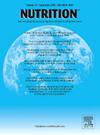Effectiveness of 8-hour time-restricted eating combined with different dietary patterns on body composition, lipid metabolism, and oxidative stress in healthy adults: An exploratory study from an RCT
IF 3.2
3区 医学
Q2 NUTRITION & DIETETICS
引用次数: 0
Abstract
Objectives
To evaluate the effectiveness of a 4-week intervention of time-restricted eating (TRE) alone or in combination with an elimination of ultra-processed foods or vegetarian diet, on body composition, lipid metabolism, and oxidative stress.
Methods
This was a randomized controlled trial including 70 participants comparing three diet groups maintained for a 4-week period: A, TRE alone; B, TRE with elimination of ultra-processed foods; and C, TRE with a vegetarian diet. Per-protocol analyses of body composition, plasma lipid levels, and oxidative stress markers were performed.
Results
Compared to baseline, Group B significantly reduced weight (P = 0.02), body mass index, waist and hip circumference, as well as fat ratio, total cholesterol, 4-hydroxynonenal an 8-Iso prostaglandin F 2α (all P < 0.05). Group B also increased high-density lipoprotein cholesterol (P < 0.05) and catalase (P = 0.002). Compared to Group A, Group B was more effective in decreasing body mass index (Δ: –0.1 ± 0.7 vs. –0.2 ± 0.3, respectively, P = 0.041) and waist circumference (Δ: –1.1 ± 4.0 vs. –3.5 ± 4.4, P < 0.001). Compared to Group A and B, the increase in superoxide dismutase (Δ: 12.74 ± 8.34, P < 0.05) and glutathione (Δ: 0.63 ± 0.40, P < 0.05) was significantly greater for Group C. Group C also produced a greater decrease in malondialdehyde (Δ: –0.79 ± 0.28) than the Group A (Δ: –0.32 ± 0.51, P < 0.001) and Group B (Δ: –0.20 ± 0.68, P < 0.001) diets.
Conclusions
Consumption of ultra-processed foods can increase body composition and lipid profile, despite TRE. A vegetarian diet in combination with TRE is effective in reducing oxidative stress injury.
8小时限时饮食结合不同饮食模式对健康成人身体组成、脂质代谢和氧化应激的影响:一项来自随机对照试验的探索性研究
目的评价限时饮食(TRE)单独干预或与超加工食品或素食联合干预4周对身体成分、脂质代谢和氧化应激的影响。方法:这是一项随机对照试验,包括70名参与者,比较三个饮食组,持续4周:a,单独饮食;B、消除超加工食品的TRE;C,吃素食。按方案分析身体成分、血脂水平和氧化应激标志物。结果与基线相比,B组患者体重(P = 0.02)、体重指数、腰臀围、脂肪比、总胆固醇、4-羟基烯醛和8-Iso前列腺素f2 α (P <;0.05)。B组高密度脂蛋白胆固醇(P <;0.05)和过氧化氢酶(P = 0.002)。与A组相比,B组在降低体重指数(Δ: -0.1±0.7 vs. -0.2±0.3,P = 0.041)和腰围(Δ: -1.1±4.0 vs. -3.5±4.4,P <;0.001)。与A、B组比较,超氧化物歧化酶升高(Δ: 12.74±8.34,P <;0.05)和谷胱甘肽(Δ: 0.63±0.40,P <;C组丙二醛含量(Δ: -0.79±0.28)也显著高于a组(Δ: -0.32±0.51,P <;0.001)和B组(Δ: -0.20±0.68,P <;0.001)饮食。结论:食用超加工食品可以增加身体成分和血脂,尽管有TRE。素食与三氧化三硫联合使用可有效减少氧化应激损伤。
本文章由计算机程序翻译,如有差异,请以英文原文为准。
求助全文
约1分钟内获得全文
求助全文
来源期刊

Nutrition
医学-营养学
CiteScore
7.80
自引率
2.30%
发文量
300
审稿时长
60 days
期刊介绍:
Nutrition has an open access mirror journal Nutrition: X, sharing the same aims and scope, editorial team, submission system and rigorous peer review.
Founded by Michael M. Meguid in the early 1980''s, Nutrition presents advances in nutrition research and science, informs its readers on new and advancing technologies and data in clinical nutrition practice, encourages the application of outcomes research and meta-analyses to problems in patient-related nutrition; and seeks to help clarify and set the research, policy and practice agenda for nutrition science to enhance human well-being in the years ahead.
 求助内容:
求助内容: 应助结果提醒方式:
应助结果提醒方式:


